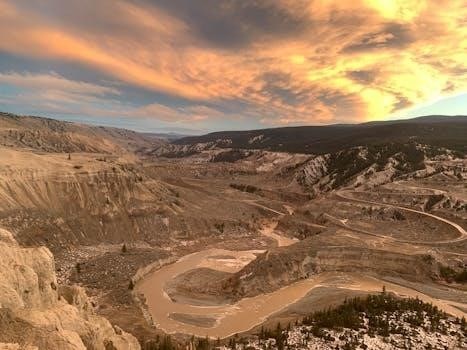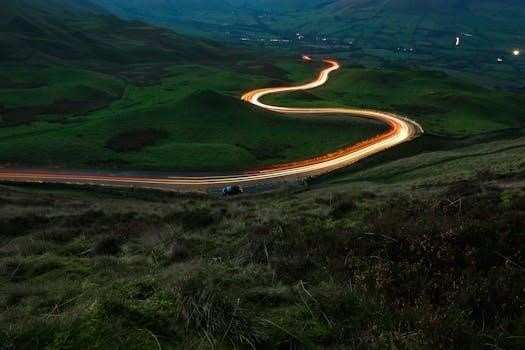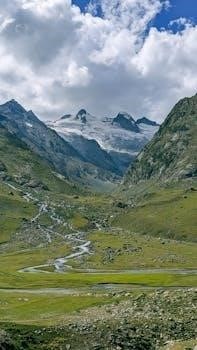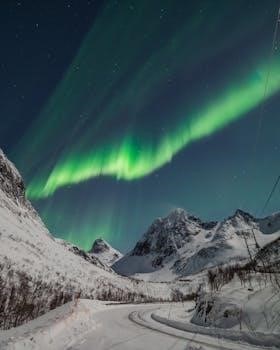Overview of Nausicaä of the Valley of the Wind
The legendary manga, created by Hayao Miyazaki, is a post-apocalyptic epic fantasy tale. It’s available in deluxe compilations, some of which are temporarily out of stock online. Online reading options and downloadable PDF versions are also available, allowing readers to explore this classic story.
Manga vs. Anime⁚ Key Differences
The anime film of Nausicaä of the Valley of the Wind, released in 1984, covers only a portion of the extensive manga series, which was written and illustrated by Hayao Miyazaki himself. The movie diverges significantly from the manga’s narrative, offering two distinct storytelling experiences. The manga, a massive achievement in storytelling, delves much deeper into the world’s mysteries and the characters’ development, revealing the true extent of the post-apocalyptic setting and its environmental devastation. It portrays a more complex and intricate narrative, whereas the anime offers a more concise adaptation of the initial plot points. The manga continues beyond the film’s scope, exploring further conflicts and character arcs not included in the movie. Many fans suggest that the full depth and intricacy of Miyazaki’s creation is only truly understood through the manga.
Hayao Miyazaki’s Creation and Vision
Hayao Miyazaki, the Academy Award-winning director, is the sole creator of both the manga and the anime of Nausicaä of the Valley of the Wind. The manga stands as a testament to his unique storytelling and artistic vision, showcasing detailed artwork and a complex narrative. Miyazaki’s work reflects his deep concern for environmental issues and his fascination with post-apocalyptic settings. He crafted a world filled with strange creatures, unique machines, and people struggling to survive in a damaged environment. His creation is a blend of intricate fantasy and science fiction, exploring themes of ecology, humanity, and the consequences of industrialization. The manga showcases his skill as both writer and artist, creating a comprehensive and immersive experience. It is through this manga that Miyazaki fully realizes his vision of this world.

The World of Nausicaä
Set in a post-apocalyptic era, the world is ravaged by environmental disaster. The Sea of Corruption, a toxic forest, dominates the landscape. Humanity struggles to survive in this altered world.
Post-Apocalyptic Setting and Environmental Disaster
The narrative unfolds in a world dramatically transformed by a cataclysmic event known as the “Seven Days of Fire,” leaving behind a post-apocalyptic landscape. Flourishing industrial civilizations have been swallowed up, and humanity is relegated to small, scattered communities. The once-familiar world is now dominated by the Sea of Corruption, a vast, toxic forest of fungi that releases poisonous spores into the air. This environmental disaster has rendered much of the planet uninhabitable, forcing the remaining populations to adapt to harsh and dangerous conditions. The lush, but deadly, environment poses a constant threat, and the remnants of past technologies are often unreliable or dangerous. In this setting, survival is a daily struggle, and the delicate balance of nature has been irrevocably altered by humanity’s past mistakes. The landscape is both beautiful and terrifying, a testament to both nature’s power and humanity’s capacity for destruction.
The Sea of Corruption and its Impact
The Sea of Corruption is not merely a setting but a central element that profoundly shapes the lives and societies within the world. This immense forest of fungi is a source of constant danger, releasing toxic spores that contaminate the air and render large areas uninhabitable. Its very existence is a direct consequence of past environmental disasters. The Sea of Corruption impacts the characters daily, forcing them to live in harmony with its deadly nature or risk succumbing to its toxins. It is a formidable barrier between communities, limiting travel and trade and fostering isolation. The unique ecology of the forest is both fascinating and terrifying, home to strange creatures and complex ecosystems. The poisonous miasma is an ever-present threat that influences culture, technology, and the very way people perceive their world. This environment is a constant reminder of the consequences of humanity’s hubris.

Character and Story
The narrative centers on Nausicaä, a compassionate princess, and her journey through a world ravaged by environmental disaster. Political conflicts and war further complicate her path as she strives for understanding and peace.
Nausicaä⁚ The Compassionate Princess
Nausicaä, the princess of the Valley of the Wind, is a central figure known for her deep compassion and understanding. She assumes leadership responsibilities following her father’s illness, demonstrating her strength and determination. Her love for life and others motivates her to study the complex ecology of her world, seeking to understand the mysteries of the toxic Sea of Corruption. She is a proactive character, not just a passive observer, who strives to find solutions to the environmental issues affecting her world and the conflicts that plague humanity. Nausicaä’s dedication to peace and her profound respect for all forms of life make her a unique and inspiring protagonist. Her actions and her unwavering belief in the possibility of coexistence form a core theme throughout her epic story. She is a proactive force, shaping her destiny and the future of her world through her actions and ideas.
Political Conflicts and the War
The narrative of Nausicaä is deeply intertwined with significant political conflicts and the looming threat of war. A key conflict arises between the Kingdom of Torumekia and the Dorok Empire, pulling smaller nations like the Valley of the Wind into the turmoil. Nausicaä, as princess, finds herself at the center of these escalating tensions, forced to navigate treacherous political landscapes while trying to protect her people and prevent widespread destruction. The war serves as a backdrop highlighting the destructive nature of human conflict, with power struggles and territorial ambitions leading to immense suffering. Nausicaä’s attempts to broker peace are further complicated by the manipulations and hidden agendas of various political factions, revealing the complexities and dangers of power dynamics in her world. These conflicts add another layer to her character, demonstrating her leadership during times of adversity.

Formats and Availability
The manga is available in deluxe editions and compilations. Viz Media has published it in various formats. Online reading and PDF versions can be found, though availability may vary. Some editions may be temporarily out of stock.
Deluxe Manga Editions and Compilations
Hayao Miyazaki’s acclaimed manga series, “Nausicaä of the Valley of the Wind,” has seen several deluxe editions and compilations, offering fans a chance to experience the epic story in high-quality formats. These editions often feature larger page sizes, enhanced printing, and additional materials, making them a must-have for collectors. The deluxe versions sometimes combine multiple volumes into a single, substantial book, providing a complete experience. These compilations highlight the intricate artwork and detailed world-building that Miyazaki is known for. They also offer a more immersive reading experience compared to the standard editions. Availability of these deluxe versions may fluctuate, with some temporarily out of stock online, making them highly sought after by enthusiasts. These editions aim to preserve the original art while enhancing the reading experience. The collected editions also provide a more convenient way to read the manga, especially for those who may not have access to the individual volumes. These deluxe formats are a testament to the enduring legacy of Miyazaki’s work.
Viz Media’s Publication History
Viz Media has played a crucial role in bringing “Nausicaä of the Valley of the Wind” to English-speaking audiences. They initially published the manga in a serialized format, releasing 27 issues over several years, starting in 1990. These issues were later compiled into seven graphic novels, which became widely available. Viz Media also released a four-volume reprint of the manga, making it accessible to a new generation of readers. They further enhanced the reading experience by publishing a deluxe two-volume box set in 2012, offering a premium version of the classic series. The box set retained the original artwork unflipped, with untranslated sound effects, aiming to provide an authentic experience. Viz Media’s various publications have contributed significantly to the manga’s popularity. These publications are often sought after by collectors and fans of both manga and Miyazaki. This history highlights Viz Media’s commitment to bringing influential manga to the West;
Online Reading and PDF Availability
For those seeking digital access, “Nausicaä of the Valley of the Wind” offers various online reading options. Several websites host scanned versions of the manga, allowing readers to explore the story chapter by chapter. Some platforms offer free access, while others may require subscriptions. These online platforms often include features like page-turning capabilities and zoom functions, enhancing the digital reading experience. Furthermore, PDF versions of the manga are also available for download, providing an alternative for offline reading. These PDF files may include complete volumes or individual chapters. The availability of these digital formats ensures that fans can enjoy Miyazaki’s work regardless of their location or access to physical copies. However, it’s important to note that some online sources may be of varying quality, and it’s best to seek out reputable sites. The digital accessibility has contributed to the enduring popularity of the manga.

Critical Reception and Legacy
This manga is a massive achievement, lauded as one of the best epic fantasy/SF stories. Its influence is significant in both manga and anime, with enduring themes of ecology and humanity, solidifying its legacy.
Significance in Manga and Anime
Nausicaä of the Valley of the Wind holds a pivotal position in both manga and anime history. The manga, a work of singular authorship by Hayao Miyazaki, is considered a monumental achievement in storytelling, praised for its intricate detail and epic scope. It stands as a testament to Miyazaki’s visionary artistry, setting a high bar for the fantasy and science fiction genres. The anime adaptation, while covering only a portion of the manga’s vast narrative, was instrumental in establishing Studio Ghibli’s reputation and influence. The film’s success helped pave the way for future Ghibli masterpieces. Both the manga and anime have left an indelible mark on the industry, influencing countless creators and captivating audiences worldwide. The manga’s complex narrative delves deep into themes of environmentalism, humanity, and war, making it more than just a fantasy story. It is a profound exploration of our relationship with nature and each other. The film’s stunning visuals and powerful message further solidified its place as a landmark achievement. The combination of the manga’s profound storytelling and the anime’s visual artistry has ensured that Nausicaä remains a relevant and cherished work.
Themes of Ecology and Humanity
The narrative of Nausicaä of the Valley of the Wind is deeply rooted in themes of ecology and humanity’s impact on the natural world. The story depicts a post-apocalyptic setting where industrial civilizations have been decimated, leading to the rise of the Sea of Corruption, a toxic fungal forest. The miasma produced by this forest highlights the consequences of environmental destruction and humanity’s hubris. The series explores the delicate balance of ecosystems and the importance of understanding and respecting nature. The compassionate princess, Nausicaä, embodies a deep connection to the natural world, studying the ecology of her world and seeking solutions to environmental challenges. Her actions reflect a desire for harmony rather than dominance over nature. The conflict between the human desire for control and nature’s resilience is a recurring theme, prompting readers to consider their own impact on the planet. The story serves as a cautionary tale, urging humanity to reflect on its role in the destruction and potential restoration of the natural world. The themes of ecology and humanity are interwoven, showing how our choices directly affect the environment and our future survival.

